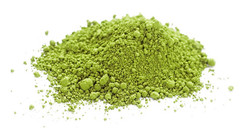Trending: Matcha Tea
[fusion_builder_container hundred_percent=”yes” overflow=”visible”][fusion_builder_row][fusion_builder_column type=”1_1″ background_position=”left top” background_color=”” border_size=”” border_color=”” border_style=”solid” spacing=”yes” background_image=”” background_repeat=”no-repeat” padding=”” margin_top=”0px” margin_bottom=”0px” class=”” id=”” animation_type=”” animation_speed=”0.3″ animation_direction=”left” hide_on_mobile=”no” center_content=”no” min_height=”none”]
Hundreds of websites are touting the supposed health benefits of Matcha. They hype claims of “137 times the ECGC of other green teas.” Don’t you believe it! That nonsense comes from one study done by…drumroll please… Starbucks, which happens to sell their Tazo brand Matcha tea. The USDA has a more scientific approach. Basically it says that the average level of antioxidants in green tea is about 80-mg per cup. That would mean that Matcha has 10,960-mg. Not only is this an exaggeration, if it were true (which it isn’t), that high level would actually be dangerous. A Chemical Research and Toxicology report found that drinking more than 750-mg can make people nauseous, and higher levels can cause liver toxicity and other health issues. Matcha is made by grinding the whole tea leaf into a fine powder. As soon as the leaf is ground, the antioxidants begin to dissipate, and within 3 months the levels are virtually non-existent. This is why whole leaf tea is a far better choice than tea found in the typical tea bag. The antioxidants remain in the leaf, and begin to be released once the dry leaves are broken. So the actual fact is, Matcha Tea has no more antioxidants than other teas from the camellia sinensis plant. By the time it makes it to your kitchen, maybe it has less! The strong taste of Matcha encourages the addition of milk and/or sugar. Those additives coat the stomach lining causing a reduction in the absorption of antioxidants.
Speaking of health, there’s an even bigger danger lurking. All teas contain lead which is absorbed from the ground. Matcha contains 2.5-mcg to 7-mcg of lead, which the USDA labels as unsafe. Since Matcha is created by grinding the whole leaf, the full strength of the lead is ingested when you drink it. Regular whole leaf tea is well within the recommended 2-mcg of lead USDA guideline because 90% of the lead remains in the leaf when brewed. In a similar vein, the caffeine content of Matcha is very high. That might make a nice pick-me-up in the afternoon…but is it worth the risks? Only drink Matcha that is 100% USDA certified organic.
At GLF Tea USA we care about your health, as well as providing great aroma and flavor. Our White Teas are the highest grade available which gives you the highest antioxidant levels as well as the best taste. Our Matcha is carefully selected and tested, and we only sell the top grade ceremonial organic Matcha tea.
References for this story:
USDA.gov
Consumerlab.com
GLFTeaUSA.com
Green Tea Guide
[/fusion_builder_column][/fusion_builder_row][/fusion_builder_container]

